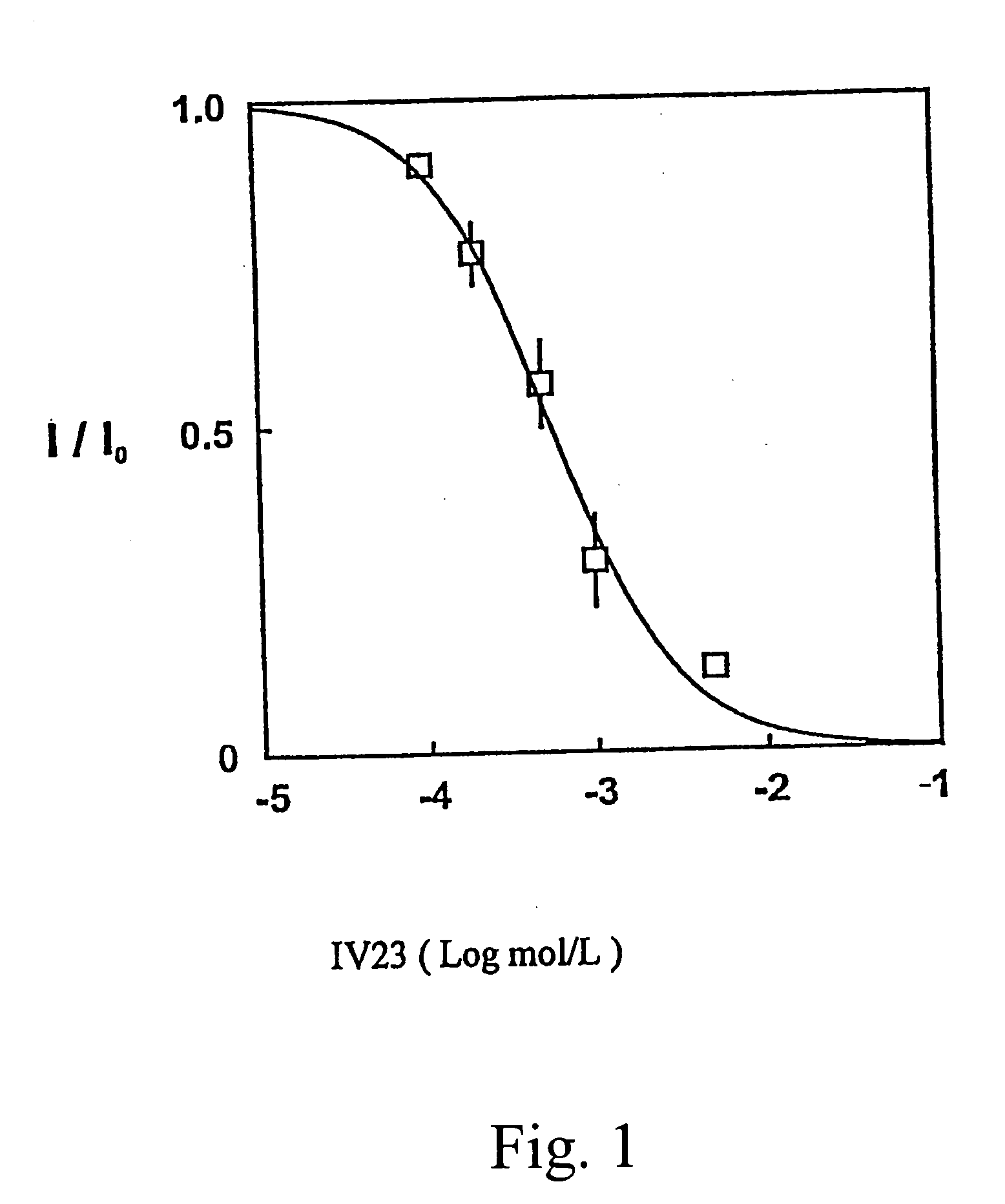Aralkyl formly-alkyl piperazine derivatives and their uses as a cerebral nerve protective agent
- Summary
- Abstract
- Description
- Claims
- Application Information
AI Technical Summary
Benefits of technology
Problems solved by technology
Method used
Image
Examples
example 1
(IV-2) N1, N4-diphenacyl piperazine dihydrochloride
[0052] A mixture of piperazine (2 g, 23.22 mmol), 2-chloro-1-phenylethanone (7.89 g) and K2CO3 (8 g, 58.08 mmol) in 30 ml of DMF was stirred at 50° C. for 8 h, and treated according to the general preparation 2 to give 6.6 g of compound (IV-2) (72%), mp 258-259° C., M+ 322.
[0053] Elemental analysis (found): C20H22N2O2.2HCl (C: 60.91%, H: 6.40%, N, 7.26%)
[0054]1HNMR (DMSO-d6): δ 3.46 (m, 8H, piperazine-H), 5.09 (s, 4H: 2COCH2N), 7.59-8.02 (m, 10H, ArH).
example 2
(IV-7) N1-(2-naphthoylmethyl)-N4-phenacyl-piperazine dihydrochloride
[0055] A mixture of N-formyl piperazine (20 g, 175 mmol), 2-chloro-1-phenylethanone (32.5 g, 210 mmol) and K2CO3 (36 g, 262 mmol) in 180 ml of acetone was treated according to the general preparation 1 to give N-phenacyl piperazine dihydrochloride, 28 g (57%), mp 246-8° C. (dec).
[0056] A mixture of 2-bromo-1-(naphthalen-2-yl)ethanone (0.95 g, 3.8 mmol), N-phenacyl piperazine dihydrochloride (0.89 g, 3.2 mmol) and K2CO3 (1.56 g, 11.2 mmol) in 30 ml of DMF was stirred at 50° C. for 10 h, and treated according to the general preparation 2 to give compound (IV-7), 0.88 g (60.69%), mp236-237° C., M+ 373.
[0057] Elemental analysis (found): C24H24N2O2.2HCl.1 / 2H2O.(C: 63.41%, H: 5.87%, N: 5.96%)
[0058]1HNMR (DMSO-d6 / D2O): δ 3.56 (m, 8H, piperazine-H), 4.90 (s, 2H, PhCOCH2), 5.03 (s, 2H), 7.54-8.63 (m, 12H, ArH).
example 3
(IV-8) N1-(1-benzoylethyl)-N4-phenacyl-piperazine dihydrochloride
[0059] A mixture of 2-bromo-1-phenylpropan-1-one (3 mmol), N-phenacyl piperazine dihydrochloride (2.5 mmol) and K2CO3 (8.75 mmol) in 30 ml of DMF was treated according to the general preparation 2 to give compound (IV-8), 0.64 g (62%), mp 236-238° C., M+ 336.
[0060] Elemental analysis (found): C21H24N2O2.2HCl (C: 62.02%, H: 6.64%, N, 6.57%)
[0061]1HNMR (DMSO-d6): δ 1.73 (d, J=6.0, 3H, COCH(CH3)N), 3.56 (m, 8H, piperazine-H), 5.44 (m, br, 1H, COCHN), 4.90 (s, 2H, PhCOCH2), 7.55-8.05 (m, 10H, ArH).
PUM
| Property | Measurement | Unit |
|---|---|---|
| Volume | aaaaa | aaaaa |
| Mass | aaaaa | aaaaa |
| Molar density | aaaaa | aaaaa |
Abstract
Description
Claims
Application Information
 Login to View More
Login to View More - R&D
- Intellectual Property
- Life Sciences
- Materials
- Tech Scout
- Unparalleled Data Quality
- Higher Quality Content
- 60% Fewer Hallucinations
Browse by: Latest US Patents, China's latest patents, Technical Efficacy Thesaurus, Application Domain, Technology Topic, Popular Technical Reports.
© 2025 PatSnap. All rights reserved.Legal|Privacy policy|Modern Slavery Act Transparency Statement|Sitemap|About US| Contact US: help@patsnap.com



